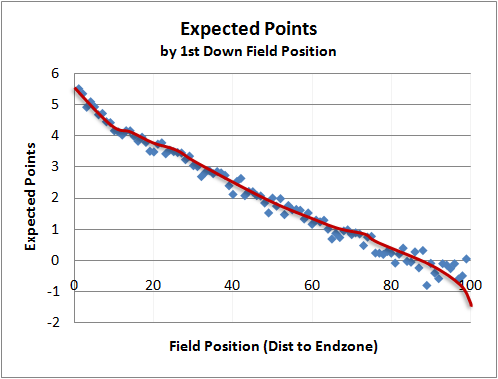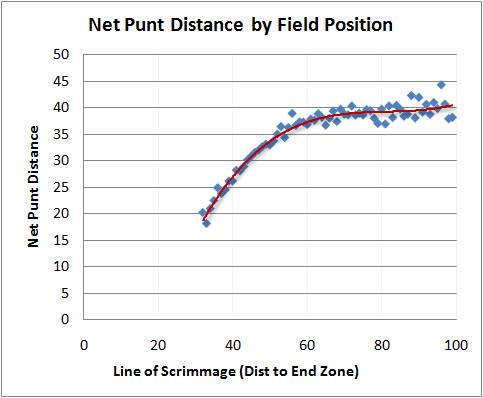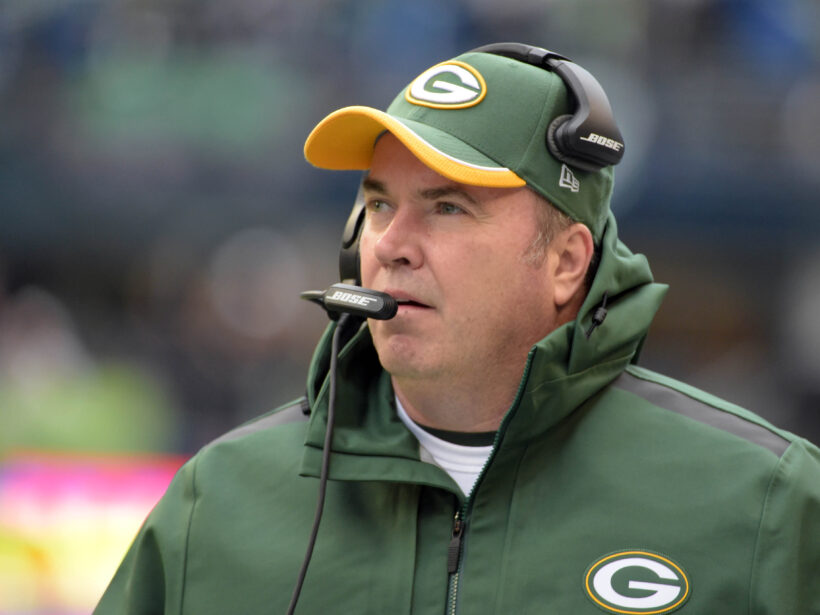Nothing that happens on the field in OTAs really means anything, so trying to find any meaningful stories about the Green Bay Packers this time of year is tough. One thing that really peaked my interest was Mike McCarthy’s comments about going for two-point conversions more often this year after Ben Roethlisberger and Drew Brees expressed their desires to go for two-points after every touchdown.
“Personally, I definitely agree with Ben and Drew. I think especially with Aaron (Rodgers) being our quarterback, I would have zero issue as an offensive coach going for it every single time,” McCarthy said.”
“You have to look at the defense, the development of your special teams and so forth. I think there’s a little more to the question than, ‘Can we score more than 50 percent?’ Because I definitely agree with what Ben and Drew are saying, because I would definitely have the confidence to go after a defense and win more than 50 percent of them.”
The Packers were 5-for-7 on two-point conversions last year despite their overall offensive struggles. NFL kickers went 1,146-for-1,217 (94.2 percent) on extra points last season, while offenses went 45-for-94 (47.9 percent) on two-point conversions. So, basic math tells us that the extra point produced .942 points on average and two-point attempts produced .958 average points. The two-point conversion comes out ahead, but by a pretty marginal number.
Where the Packers — and the rest of the NFL — are really missing the boat is not on two-point attempts, but on fourth down attempts. To put it simply — NFL coaches are just plain gutless when it comes to going for it on fourth down — and it comes down to ignorance, stubbornness and fear as the biggest reasons why. Some NFL coaches are just from the old school and are unaware of the advantages of going for it on fourth down, even with all the research on the topic easily accessible. Others know that they should be going for fourth downs more often, but are afraid of the criticisms and consequences they will face from failing going against conventional wisdom. New Tampa Bay Buccaneers head coach Dirk Koetter admitted this about the two-point conversion topic.
“Say we go out there that first game, and we score three touchdowns and we don’t make any two pointers and we lose 21-18,” Koetter said. “Who’s going to get killed? You’re going to be on [the radio] and you’re going to be dog-cussin’ me the whole time.”
If McCarthy and his staff figured out when it would be more advantageous to go for it on fourth downs — instead of punting or kicking field goals — they would have a big edge over the rest of the NFL. Brian Burke, creator of Advanced Football Analytics and current writer for ESPN, has done amazing research into this topic. Burke came up with a system of expected points, which is basically the average potential points a team can expect in a certain situation. This chart is the expected points values for every first down position on the field.

So using Burke’s chart, you can see for example that a first down on your opponent’s 10-yard line is worth about 4.0 expected points. On the contrary, a first down on your own 10-yard line is worth alm0ost -1.0 expected points, which means your opponent on defense is more likely to score next than you are.
Burke also has expected point values for punting by figuring out the average net average for punts from each yard line based on historical value.

For example, let’s take a 4th-and-2 from your own 40-yard line. From the 40-yard line, the chart tells us to expect a net distance punt of about 37 yards, which would come out to the 23-yard line. Going back to the first chart, the 23-yard line would represent about +.2 expected points for a team with a first down there or -.2 expected points for the team that just punted.
According to Football Outsiders, NFL teams converted 4th-and-1’s and 4th-and-2’s 62 percent of the time in 2015. A successful conversion would mean getting the ball at your own 43-yard line at least, which is worth about 2.2 expected points. A failed conversion would give the opposing a team a first down likely on your 40-yard line, which is about 2 expected points for your opponent and -2 expected points for you. Using Burke’s formula, we can get a total expected points value for going for this fourth down conversion and compare it to what we just calculated for the punt.
(.62 * 2.2) + (1-.62) * -2) = .61 expected points
So, clearly .61 expected points comes out way ahead of the -.2 expected punts you would get from punting. The research has already been done for the coaches on this topic and can easily be found by a quick google search, yet no coach will ever go for this when it’s not even close that you should. Why can’t the Packers and other NFL teams come to this realization? Punting was designed in football way back in the day when games often had one or two scores in a game maximum. A punt basically guaranteed the other team was not scoring and that you would get the ball back. Today, offenses are close to unstoppable and league offensive records are being broken seemingly every season. Why coaches are so easily willingly to give up one of their four downs to score is beyond me.
Burke was part of the team that created the New York Times’ 4th down bot. You can follow the bot on Twitter or visit its website and during NFL games and it will tell you whether teams are making the right calls on fourth down. The bot has a rule of thumb for every fourth down situation. Two that I agree with personally are going for it everywhere beyond your 40-yard line on 4th-and-2’s or less and going for it on 4th-and-5’s or less between midfield and your opponent’s 33. There are some obvious exceptions based on game situations, which are built into the bot.
I went through every Green Bay drive from the 2015 season to look for those two situations I just stated. Here are the results of what they did:
GB @CHI 4th-and-3 GB 46, CHI 3, GB 0 (8:08 1st) – Punt
Out of 25 possible fourth downs in these situations the Packers only went for it eight times, and two of those times against Arizona and Minnesota were because they were down late in the game and had no choice. I’d be interested in seeing how that would compare to the league average. Look at all the potential points the Packers left on the board by punting or kicking field goals. With the way their offense was going last year they really could have used those points.
This kind of thing already cost the Packers majorly in the 2014 NFC Championship when McCarthy made the same egregious error twice in kicking field goals on Seattle’s one-yard line in the first quarter. McCarthy did not face the criticism he should have for this because of the way the Packers collapsed in the devastating loss, but you figure he would have if they had just lost like a normal team would. Then again, as Koetter said you don’t face criticism if you take the conservative route, and that is exactly what occurred here. McCarthy likely never faces the end of ti if he goes for those fourth downs and does not get them. However, the reality is he was 1,000 percent wrong here by playing scared and it played a role in costing Green Bay a trip to the Super Bowl.
If the Packers ever wanted to take advantage of going against the grain by attempting more fourth down it would behoove them to work on their short yardage offense. Albeit a small sample size, the Packers were only 2-for-8 when they did decide to go for it on fourth down in those situations listed above. According to Football Outsiders, Green Bay ranked 31st in the NFL last year converting 46.2 percent of its short yardage attempts. For a historically great offense, this has seemed like an epidemic for awhile.
The information is out there. If the Packers want to gain a strategical edge over their opponents in 2016 it will come through fourth down conversions and not two-point conversions. Maybe, they will take a closer look at this, but don’t hold your breathe.
——————
Matt Bove is a writer at PackersTalk.com. PackersTalk.com. You can follow him on twitter at @RayRobert9.
——————


1 response to “Why the Green Bay Packers Should Go For More Fourth Downs”
Matt, email me…